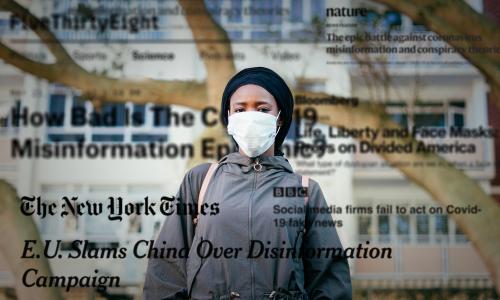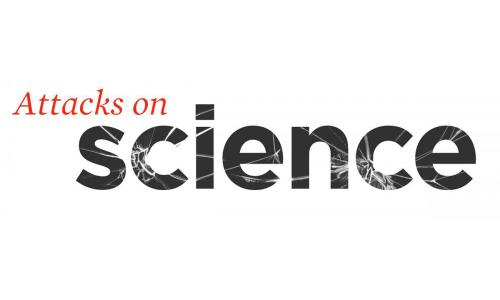During a crisis, people need accurate information to make good decisions and stay safe. With the COVID-19 pandemic devastating communities—especially communities of color, Indigenous communities and low-income communities—the need for reliable information is more urgent than ever.
In this environment, disinformation is deadly. In many cases, harmful disinformation on COVID-19 has spread just as quickly as the disease itself, drowning out credible sources of scientific information and causing immense confusion about how to protect people’s health and safety. Knowing how to identify disinformation and prevent its spread can save lives.
COVID-19 disinformation: Why and how it’s happening
UCS has studied the disinformation playbook— strategies used by corporate actors to undermine science. The goal of disinformation, whether it's disseminated by corporations or other sources, is the same: to confuse the public and control the narrative for financial, political, or ideological gain. During the COVID-19 pandemic, political leaders have spread misinformation to minimize the severity of the disease, discredit preventative social distancing measures, and sow distrust of government data.
Disinformation is more likely to take root and proliferate if people lack reliable access to accurate, up-to-date information. In the past, scientific experts have played a key role in providing such information to the public. During the COVID-19 pandemic, however, federal scientists, especially CDC scientists, were silenced by the Trump administration in a way that would have been unthinkable during previous epidemics.
In their place, the Trump administration amplified insidious forms of disinformation, such as distrusting healthcare workers concerned about the lack of capacity and resources to treat COVID-19 patients; inciting confusion over available COVID-19 treatments and the vaccine development process; and pressuring states and cities to reopen without considering scientific evidence.
In an environment where scientists are restricted from speaking and government officials announce falsehoods to the public, disinformation is all the more likely to occur and spread, with disastrous results. Strong beliefs in disinformation can result in consumers doing dangerous things (like this couple who ingested a form of chloroquine), government shelving important scientific work (like this NIH study), scientists facing serious harassment (like this researcher in Brazil), and the longterm loss of public trust in government science, which we need to be able to rely on to help keep us safe during this and future crises.
How to spot disinformation
Knowing where to find good, science-based information, and how to distinguish it from misinformation, saves lives. If you come across a piece of information, ask yourself the following questions. If the answer is “yes” to one or more of these factors, you may want to further scrutinize the information to determine its validity.
- Does it seem implausible?
- Does it confirm your beliefs or play to your emotions?
- Is it difficult to separate facts from opinions?
- Does it ignore experts (from government or reputable public health organizations)?
- Is the original source hard to pin down?
- Does the source have a stake in the claim (financial, political, etc)?
How can you tell if a source is reliable? Ask yourself these questions. If the answer to any of them is “no,” this is a source you should be wary of amplifying.
News article, video, or social media post:
- Does it identify original sources of factual content?
- Does it link to independent experts with relevant knowledge and/or to peer-reviewed science?
- Does it make it easy to identify funding sources or ideological or policy positions?
- Is it produced by an individual or organization that has an established position on the topic?
- Does it present diverse points of view fairly while acknowledging the importance of expertise?
- Does it treat individuals who have diverse perspectives with respect?
- Does it distinguish facts from opinions?
- Does it back up its statements with evidence?
- Are other news sources presenting the information similarly?
- Is the content free from racial, gendered, or otherwise problematic stereotypes?
- Is the information consistent with what scientists and other experts have said on the topic?
Report or study:
- Are the authors experts on the subject?
- Is the study peer-reviewed?
- Have the authors disclosed their conflicts of interest and funding sources? If yes, does the sponsor have a vested interest in the outcome of the study?
- Does the publisher have a preexisting policy or ideological position on the topic?
- Is the tone objective?
- Does it describe potential positives and negatives in clear terms? Does it cite and critique conflicting findings?
- If other scientists have commented about the study, are they raising major concerns with how the study was conducted?
How to stop disinformation
When you encounter a piece of disinformation, the best thing to do is stop its spread. A good first step is to practice the “inoculation method”: instead of repeating the disinformation, warn your friends, family, and co-workers about the types of COVID-19 disinformation and tactics. Research shows that when we are alerted that disinformation may occur, we tend to think more critically about the information we are encountering, thereby inoculating us from further deception.
Note that it’s critical that you don’t reshare the disinformation—even if it’s in an effort to point out that it is wrong—as you are still helping the disinformation to spread. For instance, if you share a piece of disinformation on social media in an attempt to debunk it, you are telling a social media algorithm that this item is popular, and thus encouraging it to spread even more widely. Instead, you can try the fact-myth-fallacy framework: lead with the facts, then provide a summary of the disinformation and an explanation of how or why it distorts the science.
In place of disinformation, share clear, accurate information from reputable sources. The following international and U.S. agencies, organizations, and academic institutions are trusted sources of information related to COVID-19.
- Centers for Disease Control and Prevention (CDC)
- National Institutes of Health (NIH)
- National Institute of Allergy and Infectious Diseases (NIAID)
- World Health Organization
- American Public Health Association
- Johns Hopkins University of Medicine’s Coronavirus Resource Center
- The COVID Tracking Project
- US Food and Drug Administration (FDA)
- CDC’s list of state and territorial health department websites
Do your part to ensure that public health decisions are informed by the best available science, not disinformation. Ask your elected officials and other key decisionmakers these questions:
- How will methods of collecting, assessing, and reporting COVID-19 surveillance data be made public? Are data broken down by race/ethnicity (including Indigenous groups?)
- How are CDC recommendations being incorporated into decisionmaking? Are the impacts to underserved communities being incorporated into reopening plans?
- Do marginalized communities have adequate access to affordable testing for COVID-19?
- How are testing kits and PPE being used and distributed?
- How are decisionmakers ensuring that treatments and vaccines (when available) are distributed where they are needed most? What transparency and accountability mechanisms will be built into those decisionmaking processes?
The responsibility for parsing out disinformation should not fall entirely on individuals. Social media companies, journalists, and government agencies have an important role to play in limiting disinformation and its spread. First and foremost, the federal government needs to allow the free flow of information, including amongst its own scientists, and affirm the independence of the news media. The news media needs to responsibly cover COVID-19 news by interviewing health experts, directing readers to official sources, and debunking disinformation. Social media companies have taken some steps toward removing harmful disinformation from their sites, but more must be done to improve transparency and to reduce the echo chamber effect.





